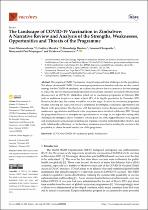| dc.contributor.author | Murewanhema, Grant | |
| dc.contributor.author | Musuka, Godfrey | |
| dc.contributor.author | Denhere, Knowledge | |
| dc.date.accessioned | 2022-07-14T09:43:43Z | |
| dc.date.available | 2022-07-14T09:43:43Z | |
| dc.date.issued | 2022 | |
| dc.identifier.citation | Murewanhema, G. et al. (2022). The landscape of Covid-19 vaccination in Zimbabwe: A narrative review and analysis of the strengths, weaknesses, opportunities and threats of the programme. Vaccines, 10(2), 262. https://doi.org/10.3390/vaccines10020262 | en_US |
| dc.identifier.issn | 2076-393X | |
| dc.identifier.uri | https://doi.org/10.3390/vaccines10020262 | |
| dc.identifier.uri | http://hdl.handle.net/10566/7597 | |
| dc.description.abstract | The ongoing COVID-19 pandemic brought unprecedented challenges for the population.
The advent of national COVID-19 vaccination programmes was therefore welcome as a key control
strategy for the COVID-19 pandemic, as evidence has shown that vaccination is the best strategy
to reduce the adverse individual and population level adverse outcomes associated with infectious
diseases such as COVID-19. Zimbabwe rolled out its vaccination programme in February 2021
with an ambitious target to vaccinate at least 60% of its eligible population by December 2021.
However, by that time, the country was still to reach that target. To move the vaccination programme
towards achieving this target, it is crucial to understand the strengths, weaknesses, opportunities and
threats to the programme. | en_US |
| dc.language.iso | en | en_US |
| dc.publisher | MDPI | en_US |
| dc.subject | Covid-19 vaccination | en_US |
| dc.subject | Covid-19 | en_US |
| dc.subject | Public health policy | en_US |
| dc.subject | Zimbabwe | en_US |
| dc.subject | World Health Organisation (WHO) | en_US |
| dc.title | The landscape of Covid-19 vaccination in Zimbabwe: A narrative review and analysis of the strengths, weaknesses, opportunities and threats of the programme | en_US |
| dc.type | Article | en_US |

